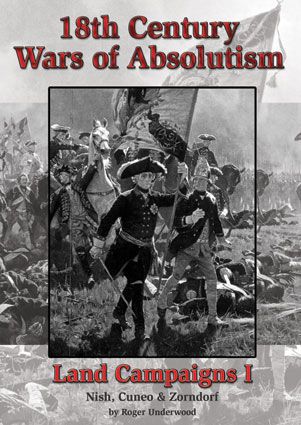|
Advertisement
|
18th Century Wars of Absolutism: Land Campaigns I – Nish, Cuneo & Zondorf

DescriptionThis Book contains 3 standalone land campaign modules. The Nish Campaign, 1737. Austrians v Ottoman Turks. The campaign ended in a disastrous failure for the Austrians following their defeats at the battle of Valjevo and the recapture of Nish by the Ottomans. The campaign includes at least one siege against a medium fortress (Nish), the probability of two other sieges and unusually the probability of some fortresses being besieged, captured and then re-besieged and recaptured by the relieving forces. Special features of this campaign include the fact that the invading army decimated by sickness and in particular malaria, eventually becomes the prey. They are pursued and virtually destroyed by an aggressive relief force led by the Grand Vizier and defeated at the battle of Valjevo. It also pits a poorly trained and equipped European army against a basically irregular Asian army with a high proportion of cavalry. The Cuneo Campaign, 1744. French and Spanish v Austrians and Sardinians. The campaign includes a potential siege or storming of a Weak Fortress, and a number of potential sieges against Weak and Medium Fortresses including the historical objectives of Demonte and Cuneo. The Gallispan lines of supply across the Alps is an important and special feature of this campaign. The French objective was to capture an important fortress to be used as a base for the campaign planned for the following year. Another feature is the fortifications known as the Barricades built by Charles Emanuel to prevent the passage of enemy troops through the Stura Valley. The maneuvering and audacity of the Gallispan attack which resulted in the capturing of the fortifications was hailed as the feat of arms in Europe at the time. The Zorndorf Campaign, 1758. Russians v Prussians. The campaign includes a potential siege or storming of a Basic Fortress, and a number of potential sieges against Weak Fortresses including the historical objective at Custrin/Kustrin (modern-day Kostrzyn). Special features of this campaign include the fact that it has one army the Prussians, actively rushing to force a battle and destroy the enemy. A definite Napoleonic strategy and a far cry from the usual 18th C. maneuvers to capture fortresses or other possessions. Each module contains its own:- Game DiscussionsAdd CommentYou need to be logged in to comment. Insert Bullet List Please enter at least one item. Item: Item: Item: Item: Item: Insert Numeric List Please enter at least one item. Item: Item: Item: Item: Item: Insert Link Please enter the link of the website Optionally you can add display text Insert Email Please enter the email address Optionally add any display text Insert Image Please enter the link of the image Insert YouTube Video Please enter the link of the video Marketplace | ||||

Comments (0)